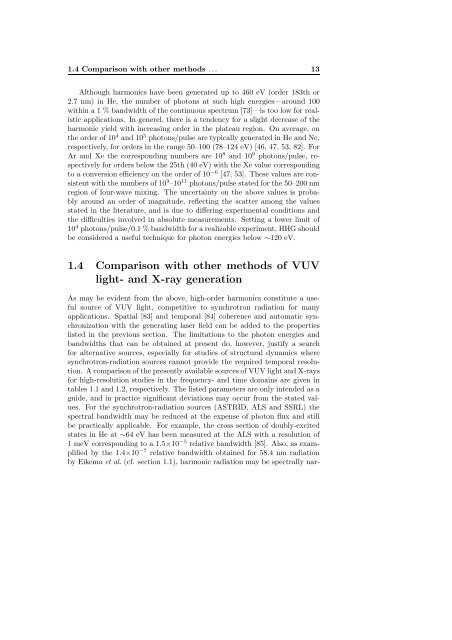VUV Spectroscopy of Atoms, Molecules and Surfaces
VUV Spectroscopy of Atoms, Molecules and Surfaces
VUV Spectroscopy of Atoms, Molecules and Surfaces
Create successful ePaper yourself
Turn your PDF publications into a flip-book with our unique Google optimized e-Paper software.
1.4 Comparison with other methods ... 13<br />
Although harmonics have been generated up to 460 eV (order 183th or<br />
2.7 nm) in He, the number <strong>of</strong> photons at such high energies—around 100<br />
within a 1 % b<strong>and</strong>width <strong>of</strong> the continuous spectrum [73]—is too low for realistic<br />
applications. In generel, there is a tendency for a slight decrease <strong>of</strong> the<br />
harmonic yield with increasing order in the plateau region. On average, on<br />
the order <strong>of</strong> 10 4 <strong>and</strong> 10 5 photons/pulse are typically generated in He <strong>and</strong> Ne,<br />
respectively, for orders in the range 50–100 (78–124 eV) [46, 47, 53, 82]. For<br />
Ar <strong>and</strong> Xe the corresponding numbers are 10 8 <strong>and</strong> 10 9 photons/pulse, respectively<br />
for orders below the 25th (40 eV) with the Xe value corresponding<br />
to a conversion efficiency on the order <strong>of</strong> 10 −6 [47, 53]. These values are consistent<br />
with the numbers <strong>of</strong> 10 9 –10 11 photons/pulse stated for the 50–200 nm<br />
region <strong>of</strong> four-wave mixing. The uncertainty on the above values is probably<br />
around an order <strong>of</strong> magnitude, reflecting the scatter among the values<br />
stated in the literature, <strong>and</strong> is due to differing experimental conditions <strong>and</strong><br />
the difficulties involved in absolute measurements. Setting a lower limit <strong>of</strong><br />
10 4 photons/pulse/0.1 % b<strong>and</strong>width for a realizable experiment, HHG should<br />
be considered a useful technique for photon energies below ∼120 eV.<br />
1.4 Comparison with other methods <strong>of</strong> <strong>VUV</strong><br />
light- <strong>and</strong> X-ray generation<br />
As may be evident from the above, high-order harmonics constitute a useful<br />
source <strong>of</strong> <strong>VUV</strong> light, competitive to synchrotron radiation for many<br />
applications. Spatial [83] <strong>and</strong> temporal [84] coherence <strong>and</strong> automatic synchronization<br />
with the generating laser field can be added to the properties<br />
listed in the previous section. The limitations to the photon energies <strong>and</strong><br />
b<strong>and</strong>widths that can be obtained at present do, however, justify a search<br />
for alternative sources, especially for studies <strong>of</strong> structural dynamics where<br />
synchrotron-radiation sources cannot provide the required temporal resolution.<br />
A comparison <strong>of</strong> the presently available sources <strong>of</strong> <strong>VUV</strong> light <strong>and</strong> X-rays<br />
for high-resolution studies in the frequency- <strong>and</strong> time domains are given in<br />
tables 1.1 <strong>and</strong> 1.2, respectively. The listed parameters are only intended as a<br />
guide, <strong>and</strong> in practice significant deviations may occur from the stated values.<br />
For the synchrotron-radiation sources (ASTRID, ALS <strong>and</strong> SSRL) the<br />
spectral b<strong>and</strong>width may be reduced at the expense <strong>of</strong> photon flux <strong>and</strong> still<br />
be practically applicable. For example, the cross section <strong>of</strong> doubly-excited<br />
states in He at ∼64eV has been measured at the ALS with a resolution <strong>of</strong><br />
1 meV corresponding to a 1.5×10 −5 relative b<strong>and</strong>width [85]. Also, as examplified<br />
by the 1.4×10 −7 relative b<strong>and</strong>width obtained for 58.4nm radiation<br />
by Eikema et al. (cf. section 1.1), harmonic radiation may be spectrally nar-















